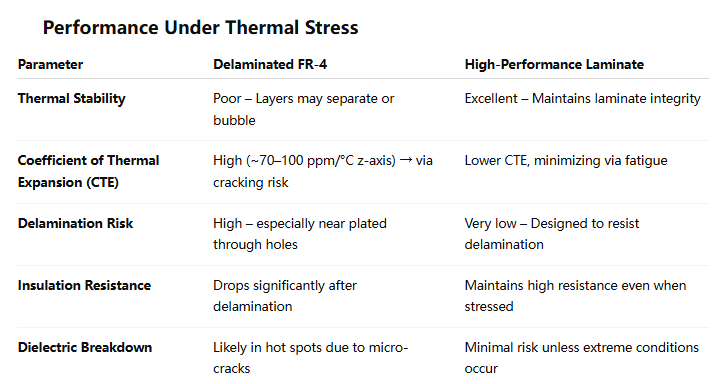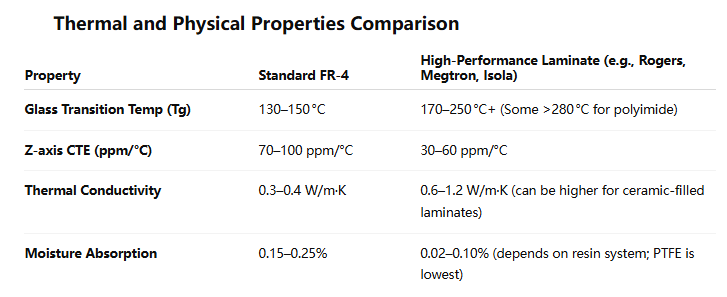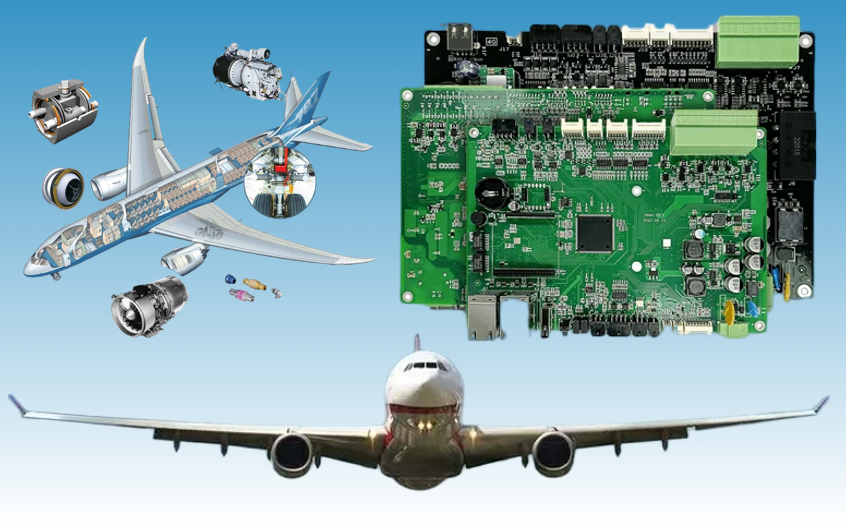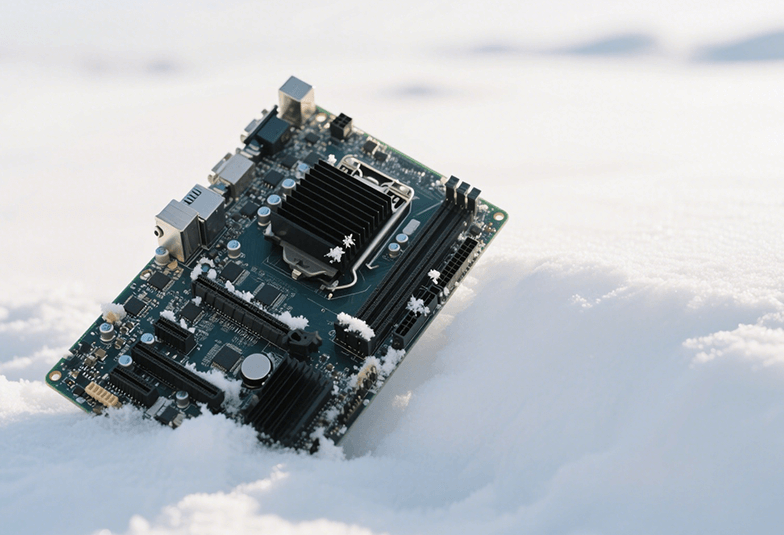When designing printed circuit boards (PCBs) for extreme environments, choosing the right laminate material is critical to prevent delamination and ensure reliability. While FR-4 is a popular and cost-effective choice for many applications, it often falls short in high-temperature, high-stress, or harsh conditions like those found in aerospace and automotive industries. This blog post explores advanced PCB laminates beyond FR-4, focusing on high-temperature PCB laminates, low CTE PCB materials, and delamination resistant PCB substrates. We'll guide you through selecting PCB materials for aerospace and automotive PCB delamination prevention, ensuring your designs perform under pressure.
Why FR-4 Isn’t Always Enough for Extreme Environments
FR-4, a widely used PCB laminate made of woven fiberglass and epoxy resin, works well for standard electronics with operating temperatures up to about 130°C. However, in extreme environments—think aerospace systems facing temperatures above 150°C or automotive applications enduring constant thermal cycling—FR-4 can suffer from delamination. Delamination occurs when layers of the PCB separate due to thermal stress, moisture absorption, or mechanical strain, leading to circuit failure.
In high-temperature settings, FR-4’s relatively high coefficient of thermal expansion (CTE) causes it to expand and contract unevenly, stressing solder joints and vias. Its glass transition temperature (Tg), typically around 130-140°C, also limits its ability to withstand prolonged heat exposure. For industries where reliability is non-negotiable, moving beyond FR-4 to specialized laminates is essential.

Understanding Delamination in Extreme Environments
Delamination is a critical failure mode in PCBs, especially in harsh conditions. It happens when the bond between the laminate layers or between the laminate and copper foil weakens. Common causes include:
- Thermal Stress: Repeated heating and cooling cycles cause materials to expand and contract at different rates, creating internal stress.
- Moisture Absorption: Absorbed moisture can vaporize during high-temperature processes like soldering, leading to layer separation.
- Mechanical Stress: Vibration and physical shock, common in automotive and aerospace applications, can weaken laminate bonds.
In extreme environments, such as an aircraft’s avionics system operating at altitudes with temperature swings from -55°C to 85°C, or an automotive engine control unit exposed to heat up to 150°C, delamination risks are magnified. Choosing a delamination resistant PCB substrate becomes a priority to ensure long-term performance.
Key Factors in Selecting High-Temperature PCB Laminates
When moving beyond FR-4, several material properties must be considered to combat delamination in extreme conditions. Let’s break down the most important factors for selecting high-temperature PCB laminates.
1. Glass Transition Temperature (Tg)
The Tg is the temperature at which a laminate transitions from a rigid to a more flexible state. For high-temperature applications, choose laminates with a Tg of 170°C or higher. Materials like polyimide or high-Tg epoxy blends can withstand temperatures up to 260°C without losing structural integrity, making them ideal for aerospace and automotive designs.
2. Coefficient of Thermal Expansion (CTE)
Low CTE PCB materials are crucial for minimizing thermal stress. CTE measures how much a material expands or contracts with temperature changes. A mismatch between the CTE of the laminate and other components, like copper (which has a CTE of about 17 ppm/°C), can lead to cracks or delamination. Advanced laminates, such as those with ceramic fillers, offer CTE values as low as 6-8 ppm/°C, closely matching copper and reducing stress during thermal cycling.
3. Thermal Conductivity
High thermal conductivity helps dissipate heat, reducing the risk of hotspots that contribute to delamination. Standard FR-4 has a thermal conductivity of around 0.3 W/m·K, while specialized laminates like metal-core or ceramic-based materials can achieve values of 1-3 W/m·K or higher, ensuring better heat management in extreme environments.
4. Moisture Resistance
Materials with low moisture absorption rates are essential for preventing delamination caused by vapor pressure during soldering or operation in humid conditions. Polyimide and certain resin systems absorb less than 0.2% moisture by weight, compared to FR-4’s 0.8-1.0%, making them a better choice for harsh environments.

Top Alternatives to FR-4 for Extreme Environments
Now that we’ve covered the key properties to look for, let’s explore some of the best high-temperature PCB laminates and delamination resistant PCB substrates available for extreme environments.
1. Polyimide Laminates
Polyimide is a go-to material for high-temperature applications, with a Tg often exceeding 250°C. It offers excellent thermal stability, low moisture absorption, and a CTE of around 12-14 ppm/°C, making it suitable for aerospace systems exposed to wide temperature ranges. Polyimide is also highly resistant to chemicals, which is a bonus in harsh industrial settings.
2. High-Tg Epoxy Blends
For applications where cost is a concern but performance beyond FR-4 is needed, high-Tg epoxy laminates with Tg values of 170-180°C are a good middle ground. They provide better thermal resistance than standard FR-4 and are often used in automotive electronics for engine control units and power management systems.
3. Ceramic-Filled Laminates
Ceramic-filled laminates offer extremely low CTE values (6-8 ppm/°C) and high thermal conductivity (up to 3 W/m·K). These materials are ideal for applications requiring precise dimensional stability, such as satellite communication systems in aerospace. Their rigidity also helps resist mechanical stress, reducing delamination risks.
4. PTFE-Based Laminates
Polytetrafluoroethylene (PTFE) laminates are known for their low dielectric loss and excellent thermal stability, with a Tg often above 200°C. While primarily used in high-frequency applications, their low moisture absorption (less than 0.1%) and CTE of around 10-12 ppm/°C make them a strong choice for preventing delamination in extreme conditions.

Selecting PCB Materials for Aerospace Applications
Aerospace PCBs must endure extreme temperature swings, high altitudes, and intense vibrations while maintaining signal integrity and structural stability. When selecting PCB materials for aerospace, prioritize the following:
- High Tg and Low CTE: Materials like polyimide or ceramic-filled laminates handle temperature ranges from -55°C to 125°C or higher, common in avionics and satellite systems.
- Lightweight Design: Aerospace applications often require lightweight materials to reduce fuel costs. Thin, high-performance laminates can meet these needs without sacrificing durability.
- Radiation Resistance: In space applications, materials must resist radiation damage. Certain polyimide blends are formulated to withstand cosmic radiation, ensuring long-term reliability.
For example, a satellite communication board might use a ceramic-filled laminate with a CTE of 7 ppm/°C to maintain dimensional stability during thermal cycles in orbit, preventing delamination and ensuring consistent performance.
Automotive PCB Delamination Prevention Strategies
In the automotive industry, PCBs are exposed to heat from engines, vibration from road conditions, and humidity in various climates. Automotive PCB delamination prevention starts with material selection but also includes design and manufacturing considerations.
Material Choices for Automotive PCBs
Opt for high-Tg epoxy blends or polyimide laminates with Tg values above 170°C for under-the-hood applications like engine control units. These materials can handle sustained temperatures of 125-150°C without delaminating. Low CTE materials (below 10 ppm/°C) are also critical to match the expansion rates of other components during thermal cycling.
Design Tips to Prevent Delamination
Beyond material selection, design practices can minimize delamination risks:
- Minimize Layer Count: Fewer layers reduce the number of interfaces where delamination can occur.
- Use Symmetrical Stackups: Balanced copper distribution across layers helps manage thermal expansion evenly.
- Incorporate Vias Strategically: Avoid placing vias in high-stress areas to reduce mechanical strain points.
Manufacturing Best Practices
During fabrication, ensure proper curing of the laminate to eliminate trapped moisture, and use controlled lamination pressures to achieve strong interlayer bonding. Post-fabrication baking at 120-150°C for 2-4 hours can further reduce moisture content before assembly.
How to Test and Validate Laminate Performance
Before committing to a laminate for your design, testing its performance under simulated extreme conditions is crucial. Common tests include:
- Thermal Cycling Tests: Subject the PCB to temperature swings (e.g., -40°C to 125°C) for 500-1000 cycles to evaluate CTE mismatch and delamination risks.
- Humidity Exposure: Test moisture absorption by exposing the board to 85% relative humidity at 85°C for 168 hours, then check for layer separation.
- Mechanical Stress Tests: Apply vibration or shock to mimic real-world conditions, ensuring the laminate withstands physical strain.
These tests help confirm that your chosen delamination resistant PCB substrate will perform reliably in the field, whether in an aircraft wing or under an automotive hood.
Balancing Cost and Performance in Laminate Selection
High-performance laminates like polyimide or ceramic-filled materials often come at a higher cost than FR-4. However, the investment pays off in reliability and reduced failure rates in extreme environments. For less demanding applications within aerospace or automotive systems, consider hybrid stackups that combine FR-4 with high-Tg layers in critical areas, balancing cost and performance.
For instance, a hybrid design might use a high-Tg epoxy laminate for the power section of an automotive PCB while using standard FR-4 for less stressed signal layers, achieving a cost-effective yet robust solution.
Conclusion: Building Reliable PCBs for Extreme Conditions
Choosing the right PCB laminate is a foundational step in combating delamination in extreme environments. While FR-4 serves many applications well, high-temperature PCB laminates, low CTE PCB materials, and delamination resistant PCB substrates are essential for the demanding conditions of aerospace and automotive industries. By focusing on material properties like Tg, CTE, thermal conductivity, and moisture resistance, and by following best practices in design and manufacturing, you can ensure your PCBs perform reliably under stress.
Whether you’re selecting PCB materials for aerospace systems enduring sub-zero temperatures or implementing automotive PCB delamination prevention strategies for engine control units, moving beyond FR-4 to advanced laminates offers the durability and performance you need. With careful selection and testing, your designs can withstand the harshest environments without compromising on quality.

 ALLPCB
ALLPCB







